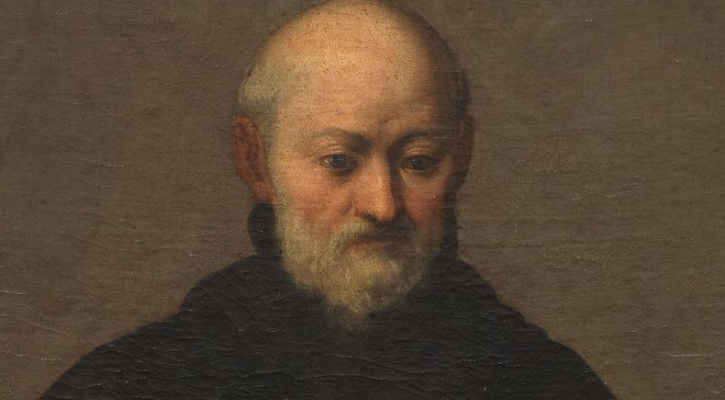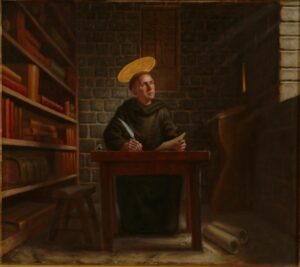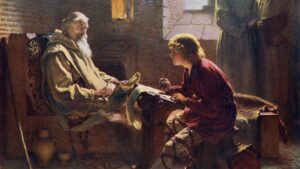
OBLATE BOY
St. Bede was a monk, priest, historian, scholar, and a prolific and important translator and writer. Born c. 673, nothing is known of Bede’s parents. His birthplace was near the town of Wearmouth in present day northern England. He was brought by relatives at age seven to the St. Peter and St. Paul monastery at Wearmouth-Jarrow. St. Peter and St. Paul were twin Benedictine monasteries located just five miles apart and under the direction of one abbot. St. Paul monastery at Jarrow was Bede’s home, and he lived the remainder of his life there. The monastery had been recently founded by the abbot [St.] Benedict Biscop, and it contained a tremendous library of manuscripts collected from throughout Europe. Bede became an oblate boy, a common practice in those times, and was one of many boys being educated and learning the monastic life.
EDUCATED BY THREE SAINTS
He came under the tutelage of the saintly abbot and other monks, and learned the domestic chores, the recreation activities, and especially the daily prayer and study characteristic of the Benedictine order. As a youth, Bede’s subjects of study included theology and Scripture, Greek, poetry, and sacred music. The abbot had brought in the arch-chanter from St. Peter’s in Rome in order to have his monks taught the appropriate chants for the divine office and the Holy Mass, many of which were in regular use until the 1960’s.
When the Abbot Biscop died in 690, his friend [St.] Ceolfrid was elected abbot and he continued the tutoring of Bede. In 692, Bede was ordained a deacon by yet another saint, Bishop [St.] John of Beverly, who also taught him. Bede continued his studies until he was ordained a priest at age thirty. After ordination, Bede continued his immersion in the monastic duties of farming, cooking, and hospitality, and offered the Mass each day for his brother monks. He found learning to be a joyful experience and he possessed an extraordinary intellect to enhance his vast knowledge after many years of study.
WRITING AND TEACHING
Declining an election as abbot, he turned to teaching and writing. He was a prolific writer, composing nearly fifty books about many subjects. Having received a firm foundation of the Christian outlook on all subjects from his three saintly teachers, he became known, even during his lifetime, as one of the most learned men of his era. His extensive writings are actually a summation of all that was known at his time. Most of his work regards the Sacred Scriptures and theology. He also wrote scientific treatises, demonstrating impressive acumen for scientific methods of gathering information and testing, and taught that the earth was spherical. He also wrote of history, poetry, philosophy, hagiography, astronomy and grammar. He wrote manuals for his students and he taught hundreds of them over the years. Some of the pillars of English society made pilgrimages to the monastery to meet Bede and request his advice. He was personally invited to Rome by Pope Sergius, but declined in order to remain a teaching monk at a monastery he was never known to have traveled far from.
Bede’s greatest work was the Historia ecclesiastica gentis Anglorum, a treasure documenting the history of the English people and the Church in that country up to the year 729. From this, we have information about the introduction of Christianity in England by the arrival of St. Augustine of Canterbury in 597 and the subsequent spreading of the Gospel there.
ANNO DOMINI
It was Bede who is largely responsible for the use of “B.C.” and “A.D.” for marking time. He recorded that a sixth century abbot first concluded that the year Our Lord was born should be the beginning of a new marking of the years, rather than the year the city of Rome was founded. This idea was not popularized however. In Bede’s writings, he first used Anno Domini nostri Jesu Christi to record what occurred after the Incarnation of Christ. Because of Bede’s far reaching influence, the practice continued in England and spread to continental Europe, where it was adopted by the Emperor Charlemagne and eventually, by the popes. Shortly before Easter of 735, Bede began having difficulty breathing, but continued teaching and writing. On May 25, the vigil of Ascension Thursday, he was completing the translation of St. John’s Gospel with a young monk taking dictation when he died while reciting the prayer known as The Glory Be. He was buried at the Jarrow monastery and his remains were later transferred to Durham Cathedral. During the sixteenth century reign of King Henry VIII and the Protestant cultural revolution, the tomb was destroyed and the remains lost.
BEDE THE VENERABLE
St. Bede became referred to as “the Venerable Bede” at a Church council in the early ninth century, and in 1899 was fittingly declared a Doctor of the Church by Pope Leo XIII, the only native Englishman to be so honored. Because of his devotion to both his monastic life and the sharing of his wealth of knowledge, his work reached far beyond his monastery. He was a humble, gentle, and kindly man who genuinely loved to teach, and whose aim was always to bring others to the eternal truths and to appreciation of God’s goodness. Most likely blind, or nearly so in his later years, he brought much light to others. St. Bede’s is especially remembered on his feast day of May 25. He is a patron of England and of English historians.


